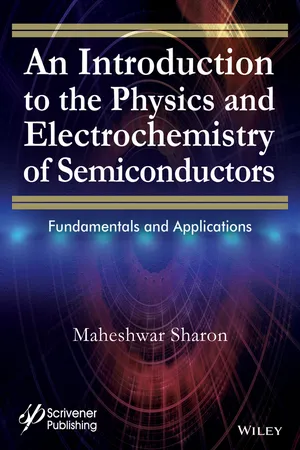
An Introduction to the Physics and Electrochemistry of Semiconductors
Fundamentals and Applications
- English
- ePUB (mobile friendly)
- Available on iOS & Android
An Introduction to the Physics and Electrochemistry of Semiconductors
Fundamentals and Applications
About This Book
This book has been designed as a result of the author's teaching experiences; students in the courses came from various disciplines and it was very difficult to prescribe a suitable textbook, not because there are no books on these topics, but because they are either too exhaustive or very elementary. This book, therefore, includes only relevant topics in the fundamentals of the physics of semiconductors and of electrochemistry needed for understanding the intricacy of the subject of photovoltaic solar cells and photoelectrochemical (PEC) solar cells. The book provides the basic concepts of semiconductors, p: n junctions, PEC solar cells, electrochemistry of semiconductors, and photochromism.
Researchers, engineers and students engaged in researching/teaching PEC cells or knowledge of our sun, its energy, and its distribution to the earth will find essential topics such as the physics of semiconductors, the electrochemistry of semiconductors, p: n junctions, Schottky junctions, the concept of Fermi energy, and photochromism and its industrial applications.
"The topics in this book are explained with clear illustration and indispensable terminology. It covers both fundamental and advanced topics in photoelectrochemistry and I believe that the content presented in this monograph will be a resource in the development of both academic and industrial research".
—Professor Akira Fujishima, President, Tokyo University of Science, and Director, Photocatalysis International Research Center, Tokyo University of Science, Japan
Frequently asked questions
Information
Chapter 1
Our Universe and the Sun
1.1 Formation of the Universe
1.2 Formation of Stars
1.2.1 Formation of Energy in the Sun


Table of contents
- Cover
- Title page
- Copyright page
- Dedication
- Foreword
- Preface
- Chapter 1: Our Universe and the Sun
- Chapter 2: Solar Energy and Its Applications
- Chapter 3: Theory of Junction Formation
- Chapter 4: Effect of Illumination of a PEC Cell
- Chapter 5: Electrochemistry of the Metal–Electrolyte Interface
- Chapter 6: Electrochemistry of the Semiconductor–Electrolyte Interface
- Chapter 7: Impedance Studies
- Chapter 8: Photoelectrochemical Solar Cell
- Chapter 9: Photoelectrochromism
- Chapter 10: Dye-Sensitized Solar Cells
- Index
- End User License Agreement